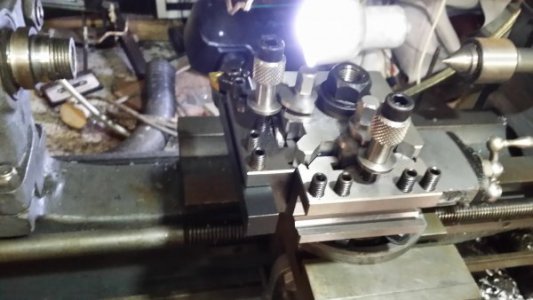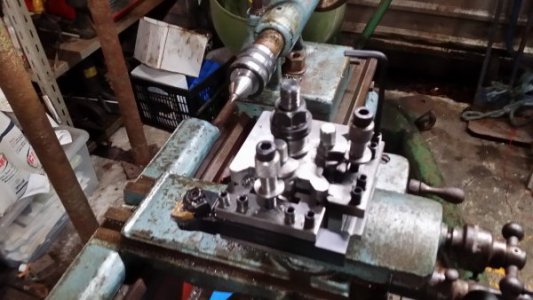- Joined
- Jan 22, 2017
- Messages
- 90
Thanks to all of you. Plenty of suggestions for me to try.
I think that the proper name for the part that I've been working on is "compound rest" - it's the top-level sliding component that holds the tool post.
I know that the part is easy to machine because it used to have a central spigot (terminology?) which fits into a depression on the cross-slide on a Myford 7. My lathe is an odd Myford/Drummond which was adapted (by an expert - not me!) to have a Myford 7 type headstock - but it still has a standard Myford/Drummond carriage. My cross-slide is flat so I had to take off the nubbin, spigot, bump thing to get it to fit on my lathe. It came off easily with a few cautious passes of the HSS end mill.
The reason that I'm working on a second-hand part from eBay is so that if I do bugger it up, I haven't wrecked my lathe: I can still use the original compound rest and tool post. I'm not a total idiot (opinions do vary on this point).
I've bought a Dixon-type QCTP - it mounts to my old Sheldon with no modification other than a top spacer for the nut and I've used that set-up very successfully. The plan is to have a suitable compound rest for the Myford/Drummond which can carry the QCTP so that I can move it from machine to machine. Now that I have the QCTP, I plan to copy the tool holders on my mill and, when my skills have improved a bit, then to copy the body so that I'll have one for each lathe.
I deliberately didn't put all of this detail in my original post because the core problem is that I have a difficult-to-work weld. I can see that everyone is wondering "Why did he do this stupid thing?" - and now you know. There was method in my madness.
Jim Dawson: that has to be the easiest step to try. I'll put on a new HSS cutter and turn the speed down.
Firstram: carbide end mills are on their way to me from the magic that is eBay. If plan "A" doesn't work then I'll post my reaction here.
BaronJ: I think you're right about the Dremmel. I'll see if I can find some suitable grinding tools for plan "C". I confess that I didn't know that such things existed.
Winegrower: I'll put annealing down as plan "D" but, if BtoVin83 is right, that I've contaminated the weld with tungsten, then I suspect it may not help.
To go back to PWaller's post: if all else fails, I suppose I could simply mill out a new body for the compound rest from a block of steel. If I do this, would it be best to use a steel that can be case-hardened? I've never done this before but I do have an oxy-acetylene torch and buckets of sand and water. What could possibly go wrong?
Thank you again, to all of you, for taking the time to post your suggestions. I promise that I'll post back with a progress update in due course. It's all learning, I suppose, and knowledge is power.
Kind wishes,
Nick
I think that the proper name for the part that I've been working on is "compound rest" - it's the top-level sliding component that holds the tool post.
I know that the part is easy to machine because it used to have a central spigot (terminology?) which fits into a depression on the cross-slide on a Myford 7. My lathe is an odd Myford/Drummond which was adapted (by an expert - not me!) to have a Myford 7 type headstock - but it still has a standard Myford/Drummond carriage. My cross-slide is flat so I had to take off the nubbin, spigot, bump thing to get it to fit on my lathe. It came off easily with a few cautious passes of the HSS end mill.
The reason that I'm working on a second-hand part from eBay is so that if I do bugger it up, I haven't wrecked my lathe: I can still use the original compound rest and tool post. I'm not a total idiot (opinions do vary on this point).
I've bought a Dixon-type QCTP - it mounts to my old Sheldon with no modification other than a top spacer for the nut and I've used that set-up very successfully. The plan is to have a suitable compound rest for the Myford/Drummond which can carry the QCTP so that I can move it from machine to machine. Now that I have the QCTP, I plan to copy the tool holders on my mill and, when my skills have improved a bit, then to copy the body so that I'll have one for each lathe.
I deliberately didn't put all of this detail in my original post because the core problem is that I have a difficult-to-work weld. I can see that everyone is wondering "Why did he do this stupid thing?" - and now you know. There was method in my madness.
Jim Dawson: that has to be the easiest step to try. I'll put on a new HSS cutter and turn the speed down.
Firstram: carbide end mills are on their way to me from the magic that is eBay. If plan "A" doesn't work then I'll post my reaction here.
BaronJ: I think you're right about the Dremmel. I'll see if I can find some suitable grinding tools for plan "C". I confess that I didn't know that such things existed.
Winegrower: I'll put annealing down as plan "D" but, if BtoVin83 is right, that I've contaminated the weld with tungsten, then I suspect it may not help.
To go back to PWaller's post: if all else fails, I suppose I could simply mill out a new body for the compound rest from a block of steel. If I do this, would it be best to use a steel that can be case-hardened? I've never done this before but I do have an oxy-acetylene torch and buckets of sand and water. What could possibly go wrong?
Thank you again, to all of you, for taking the time to post your suggestions. I promise that I'll post back with a progress update in due course. It's all learning, I suppose, and knowledge is power.
Kind wishes,
Nick


